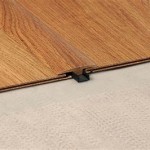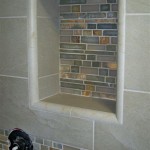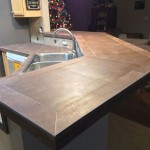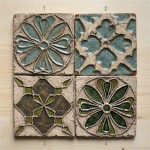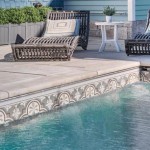10 Kitchen Wall Tile Designs to Enhance Your Popcorn Machine Setup
The presence of a popcorn machine in a kitchen indicates a penchant for entertainment and a love for homemade snacks. Elevating the surrounding aesthetic through strategic tile selection can significantly enhance the popcorn-making experience, transforming a functional appliance into a focal point of the kitchen. This article will explore ten distinct kitchen wall tile designs that can complement and improve the visual appeal of a popcorn machine setup.
The selection of tiles involves careful consideration of factors such as color palette, texture, pattern, material, and the overall design style of the kitchen. A well-chosen tile design not only enhances the aesthetic appeal but also provides practical benefits, such as ease of cleaning and resistance to spills and splatters that are common around a popcorn machine.
1. Classic Subway Tile: A Timeless Choice
Subway tile remains a popular choice for kitchen backsplashes due to its versatility and clean, minimalist aesthetic. The rectangular shape and glossy finish contribute to a bright and airy feel. For a popcorn machine setup, a classic white subway tile can provide a neutral backdrop that allows the machine to stand out. Consider using a contrasting grout color, such as black or gray, to add visual interest and define the tile pattern. Alternatively, a colored subway tile, such as a light blue or pastel green, can create a more playful and retro vibe, aligning with the nostalgic feel often associated with popcorn.
The durability of subway tile makes it a practical choice for areas prone to spills. Its smooth surface is easy to wipe clean, ensuring that any popcorn-related mishaps can be quickly addressed. Furthermore, subway tile is available in a variety of sizes and materials, including ceramic and porcelain, allowing for customization to suit different budgets and design preferences. Installation is relatively straightforward, making it a cost-effective option for a kitchen renovation project.
2. Geometric Tile: Adding Visual Intrigue
Geometric tile patterns, such as hexagons, chevrons, or triangles, can introduce a dynamic and modern element to a kitchen space. These patterns create visual interest and can serve as a statement piece behind the popcorn machine. Consider using a geometric tile with a subtle color palette to avoid overwhelming the space. A monochromatic scheme, such as varying shades of gray or beige, can provide a sophisticated and contemporary look. Alternatively, a bolder color combination can be used to create a more vibrant and playful atmosphere.
When selecting geometric tiles, it is important to consider the scale of the pattern in relation to the size of the wall. A larger pattern may be more suitable for a larger kitchen, while a smaller pattern may be more appropriate for a smaller space. Furthermore, the texture of the tile can also influence its visual impact. A textured geometric tile can add depth and dimension to the wall, creating a more tactile and engaging experience.
3. Mosaic Tile: A Touch of Artistic Flair
Mosaic tile offers a unique opportunity to incorporate intricate patterns and artistic designs into the kitchen. These tiles are typically composed of small pieces of glass, ceramic, or stone, arranged in a decorative pattern. Mosaic tile can be used to create a focal point behind the popcorn machine, adding a personalized and artistic touch to the space. Consider using a mosaic tile with a color scheme that complements the overall kitchen design. A blend of neutral colors, such as beige, gray, and white, can create a subtle and elegant look. Alternatively, a mosaic tile with vibrant colors can add a pop of personality and create a more playful atmosphere.
The level of detail in mosaic tile designs can vary greatly, from simple geometric patterns to intricate floral motifs. When selecting a mosaic tile, it is important to consider the level of detail in relation to the overall design aesthetic of the kitchen. A highly detailed mosaic tile may be more suitable for a kitchen with a minimalist design, while a simpler mosaic tile may be more appropriate for a kitchen with a more ornate design. Installation of mosaic tile can be more complex than that of larger tiles, requiring specialized tools and techniques.
4. Herringbone Pattern: A Classic with a Twist
The herringbone pattern is a variation of the subway tile design, but with a more dynamic and visually appealing layout. The tiles are arranged in a V-shaped pattern, creating a sense of movement and energy. A herringbone pattern can be used to add a touch of sophistication and elegance to the kitchen. Consider using a classic white subway tile in a herringbone pattern to create a timeless and versatile backdrop for the popcorn machine. Alternatively, a colored subway tile can be used to add a more modern and playful twist to the design.
The herringbone pattern can be oriented horizontally or vertically, depending on the desired effect. A horizontal herringbone pattern can create a sense of width, making the kitchen appear larger. A vertical herringbone pattern can create a sense of height, making the kitchen appear taller. Installation of a herringbone pattern can be more complex than that of a standard subway tile pattern, requiring careful planning and precise execution.
5. Patterned Cement Tile: Vintage Charm
Patterned cement tile offers a unique and distinctive look for kitchen walls, evoking a sense of vintage charm and character. These tiles are typically handcrafted and feature intricate designs and vibrant colors. Patterned cement tile can be used to create a focal point behind the popcorn machine, adding a touch of personality and artistry to the space. Consider using a patterned cement tile with a color scheme that complements the overall kitchen design. A tile with warm tones, such as reds, oranges, and yellows, can create a cozy and inviting atmosphere. A tile with cool tones, such as blues, greens, and purples, can create a more calming and serene atmosphere.
Due to their porous nature, cement tiles require sealing to prevent staining and water damage. Regular maintenance is essential to preserve their beauty and longevity. The intricate patterns and vibrant colors of patterned cement tiles can add a unique and artistic touch to the kitchen, making it a standout feature.
6. Glass Tile: Reflecting Light and Space
Glass tile is a versatile option that can add a touch of elegance and sophistication to the kitchen. Its reflective surface helps to bounce light around the room, creating a brighter and more spacious feel. Glass tile is available in a variety of colors, shapes, and sizes, allowing for a high degree of customization. Consider using a light-colored glass tile to maximize the reflective properties and create a bright and airy atmosphere. A blue or green glass tile can evoke a sense of tranquility and serenity. A mosaic glass tile can add a touch of sparkle and glamour to the space.
Glass tile is non-porous and easy to clean, making it a practical choice for areas prone to spills. Its smooth surface is resistant to stains and water damage. However, glass tile can be more expensive than other types of tile, and installation may require specialized tools and techniques. The reflective properties of glass tile can enhance the lighting and create a sense of spaciousness in the kitchen.
7. Stone Tile: Earthy and Textured
Stone tile brings a natural and organic element to the kitchen, adding texture and depth to the space. Stone tile is available in a variety of materials, such as granite, marble, slate, and travertine, each with its own unique characteristics and aesthetic appeal. Consider using a natural stone tile with a neutral color palette to create a warm and inviting atmosphere. A slate tile can add a rustic and earthy touch to the space. A marble tile can add a touch of elegance and luxury.
Stone tile is durable and long-lasting, but it can be more porous than other types of tile and may require sealing to prevent staining. The natural variations in color and texture of stone tile add to its unique character and appeal. The textured surface of stone tile can provide a slip-resistant surface, making it a practical choice for areas prone to spills. The earthy and organic aesthetic of stone tile can create a warm and inviting atmosphere in the kitchen.
8. Brick Tile: Rustic Industrial Appeal
Brick tile offers a unique and distinctive look for kitchen walls, evoking a sense of rustic industrial charm. Brick tile can be used to create a focal point behind the popcorn machine, adding a touch of character and texture to the space. Consider using a reclaimed brick tile to add a vintage and authentic touch to the design. A painted brick tile can create a more modern and contemporary look.
Brick tile is durable and long-lasting, but it can be more porous than other types of tile and may require sealing to prevent staining. The textured surface of brick tile can add depth and dimension to the wall, creating a more tactile and engaging experience. The rustic industrial aesthetic of brick tile can create a warm and inviting atmosphere in the kitchen.
9. Large Format Tile: Seamless Modernity
Large format tiles, characterized by their expansive size, offer a sleek and modern aesthetic to kitchen wall designs. The reduced number of grout lines creates a seamless appearance, enhancing the sense of spaciousness and minimalism. This choice is particularly effective in smaller kitchens, where the visual continuity can make the area feel larger and less cluttered. Selecting large format tiles in neutral tones, such as greys, whites, or beiges, provides a versatile backdrop that complements various popcorn machine styles and kitchen decor themes.
Beyond the aesthetic benefits, large format tiles present practical advantages. The fewer grout lines reduce the areas where dirt and grime can accumulate, simplifying cleaning and maintenance. This is especially beneficial in the vicinity of a popcorn machine, where spills and splatters are common. The smooth, unbroken surface also contributes to a more hygienic environment.
10. Mirrored Tile: Amplifying Light and Space
Mirrored tiles are an unconventional yet impactful option for kitchen wall designs. Their reflective surface dramatically amplifies light, making the kitchen appear brighter and more spacious. This is particularly advantageous in kitchens with limited natural light or those that are smaller in size. Mirrored tiles can be incorporated as a full backsplash, an accent strip, or in a mosaic pattern, depending on the desired level of reflectivity and visual impact.
While mirrored tiles offer significant aesthetic benefits, they also require careful consideration in terms of cleaning and maintenance. Fingerprints, smudges, and water spots are more visible on mirrored surfaces, necessitating regular cleaning to maintain their pristine appearance. Additionally, the installation of mirrored tiles requires precision and specialized adhesives to ensure a secure and even surface.
The 6 Best Popcorn Makers In 2024

25 Kitchen Wall Tiles Design With Tips 2024

Popcorn Maker Design Ideas

25 Kitchen Wall Tiles Design With Tips 2024

25 Kitchen Wall Tiles Design With Tips 2024

Popcorn Maker Design Ideas

Basement Popcorn Machine Design Ideas

Basement Remodel With Kitchen Theater Room Popcorn Snack Bar And Bathroom Transitional Cleveland By Cabinet S Top Houzz

Planning A Kitchen Wall Full Of Tile And Open Shelves Young House Love

Tips For Designing Your Perfect Kitchen Sbl
Related Posts

